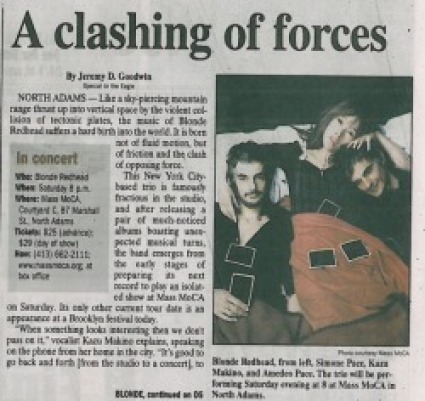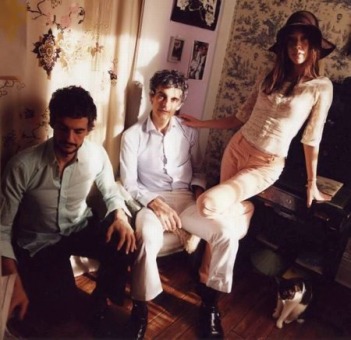"A Clashing of Forces"
Published in Berkshire Eagle, 6/26/09

By Jeremy D. Goodwin
NORTH ADAMS—Like a sky-piercing mountain range, thrust up into vertical space by the violent collision of tectonic plates, the music of Blonde Redhead suffers a hard birth into the world. It is born not of fluid motion but of friction, and the clash of opposing force.
This New York City-based trio is famously fractious in the studio, and after releasing a pair of much-noticed albums boasting unexpected musical turns, the band emerges from the early stages of preparing its next record to play an isolated show at MASS MoCA on Saturday. Its only other current tour date is an appearance at a Brooklyn festival today.
“When something looks interesting then we don't pass on it,” vocalist Kazu Makino explains, speaking on the phone from her home in the City. “It's good to go back and forth [from the studio to a concert], to play and then think about what the old material was about. It's a good way to be aware of the path you're taking.”
Indeed. A band that built up a fan base born from a particular scene and then took a couple of left turns, Blonde Redhead has spent its last two albums confounding expectations, earning accolades in the mainstream press while attracting the occasional sideways sneer from listeners and critics with loyalties closer to the group’s musical origin.
Now, the band has begun work on its next record, with its sound—and career direction—appearing to be very much in flux.
Makino speaks in a quiet voice that retains a hint of the sky-high, ethereal effect she achieves while singing. She sounds honest, unguarded, the phrase “How do you say?” dotted throughout her remarks as she searches for the proper turn of phrase.
“It doesn’t always happen harmoniously,” she says of the band’s recording process. “We were kind of breaking each other's necks and would change each other's ideas. We kind of corrupt each other,” she says of the work on Blonde Redhead’s much-celebrated previous record, 23.
“It doesn't always feel healthy. But I suppose that's what it's all about. If it's just one person's idea it might be just great for that one person but it won't be as…interesting. If we all like the same thing then there’s no point in playing together, I suppose.”
Blonde Redhead, an eminently hip trio composed of Makino (who is Japanese) and the Italian twins Amadeo (guitar/vocals) and Simone Pace (drums), strutted through the carefully noisy New York City art-rock scene after its debut album in 1995, released on the fashionable label owned by the drummer for pioneering No Wave auteurs Sonic Youth.
NORTH ADAMS—Like a sky-piercing mountain range, thrust up into vertical space by the violent collision of tectonic plates, the music of Blonde Redhead suffers a hard birth into the world. It is born not of fluid motion but of friction, and the clash of opposing force.
This New York City-based trio is famously fractious in the studio, and after releasing a pair of much-noticed albums boasting unexpected musical turns, the band emerges from the early stages of preparing its next record to play an isolated show at MASS MoCA on Saturday. Its only other current tour date is an appearance at a Brooklyn festival today.
“When something looks interesting then we don't pass on it,” vocalist Kazu Makino explains, speaking on the phone from her home in the City. “It's good to go back and forth [from the studio to a concert], to play and then think about what the old material was about. It's a good way to be aware of the path you're taking.”
Indeed. A band that built up a fan base born from a particular scene and then took a couple of left turns, Blonde Redhead has spent its last two albums confounding expectations, earning accolades in the mainstream press while attracting the occasional sideways sneer from listeners and critics with loyalties closer to the group’s musical origin.
Now, the band has begun work on its next record, with its sound—and career direction—appearing to be very much in flux.
Makino speaks in a quiet voice that retains a hint of the sky-high, ethereal effect she achieves while singing. She sounds honest, unguarded, the phrase “How do you say?” dotted throughout her remarks as she searches for the proper turn of phrase.
“It doesn’t always happen harmoniously,” she says of the band’s recording process. “We were kind of breaking each other's necks and would change each other's ideas. We kind of corrupt each other,” she says of the work on Blonde Redhead’s much-celebrated previous record, 23.
“It doesn't always feel healthy. But I suppose that's what it's all about. If it's just one person's idea it might be just great for that one person but it won't be as…interesting. If we all like the same thing then there’s no point in playing together, I suppose.”
Blonde Redhead, an eminently hip trio composed of Makino (who is Japanese) and the Italian twins Amadeo (guitar/vocals) and Simone Pace (drums), strutted through the carefully noisy New York City art-rock scene after its debut album in 1995, released on the fashionable label owned by the drummer for pioneering No Wave auteurs Sonic Youth.

It self-financed a surprising 2004 album (Misery is a Butterfly) full of unexpected, lush orchestration and a moody pop sensibility. Then the band eschewed outside producers for its follow-up, but got bogged down in the process midstream and brought in famed alterna-rock producer Alan Moulder—who had worked with marquee bands like The Smashing Pumpkins, Nine Inch Nails, and The Killers—to mix a portion of the album.
The result was 23, a smoldering, shimmering inferno of dream pop that in 2007 became the band’s commercial breakthrough. There were the inevitable protests from hipper-than-thou tastemakers who comfortably segued from complaints about the band’s similarities with Sonic Youth to objections about the new sound’s increased accessibility. But on the whole, the reaction (both popular and critical) was soundly enthusiastic.
The trio has been working on new material by writing individually, in isolation, and sending the songs back and forth—a new approach for the group. There’s no producer or All Star mixer on hand yet, but Makino says she’d like to bring Moulder back.
At this early stage, it seems unclear whether Blonde Redhead will continue to explore the hypnotic fuzz of 23, revisit the arty mope-pop of Butterfly, or re-examine the noisy experiments of its earlier work. Or go in another direction entirely.
“It really changed our music in the way that we couldn't have done it,” Makino says of Moulder’s influence on 23.
She’d like to continue in that vein, she says, but the Pace twins “are not really thinking in those terms.”
“I was really kind of working out my secret weapons. I have quite a big attachment [to it],” she continues. “Almost like, ‘Oh man, this is it for me.’ I think [the rest of the band] feel like it was just another stepping stone, but for me it was definitely songs to remember.”
With the basics for some new songs written out—in three separate rooms— Makino says the group is just now ready to start hashing out the music in person.
“We are going out of that phase, forcing ourselves to be in the room together and just playing together. Amazingly, it never feels certain. It never feels like we know what we're doing. We should know better by now, but it really feels like looking for a switch in a completely dark room. I wish it was a little easier.”
It’s too early in the album’s process to hear any of the new songs at tomorrow’s show, and perhaps catch a glimpse of the band’s next direction. But there’s an excellent chance to see some tectonic plates moving. And to enjoy the jagged rumble that results.
The result was 23, a smoldering, shimmering inferno of dream pop that in 2007 became the band’s commercial breakthrough. There were the inevitable protests from hipper-than-thou tastemakers who comfortably segued from complaints about the band’s similarities with Sonic Youth to objections about the new sound’s increased accessibility. But on the whole, the reaction (both popular and critical) was soundly enthusiastic.
The trio has been working on new material by writing individually, in isolation, and sending the songs back and forth—a new approach for the group. There’s no producer or All Star mixer on hand yet, but Makino says she’d like to bring Moulder back.
At this early stage, it seems unclear whether Blonde Redhead will continue to explore the hypnotic fuzz of 23, revisit the arty mope-pop of Butterfly, or re-examine the noisy experiments of its earlier work. Or go in another direction entirely.
“It really changed our music in the way that we couldn't have done it,” Makino says of Moulder’s influence on 23.
She’d like to continue in that vein, she says, but the Pace twins “are not really thinking in those terms.”
“I was really kind of working out my secret weapons. I have quite a big attachment [to it],” she continues. “Almost like, ‘Oh man, this is it for me.’ I think [the rest of the band] feel like it was just another stepping stone, but for me it was definitely songs to remember.”
With the basics for some new songs written out—in three separate rooms— Makino says the group is just now ready to start hashing out the music in person.
“We are going out of that phase, forcing ourselves to be in the room together and just playing together. Amazingly, it never feels certain. It never feels like we know what we're doing. We should know better by now, but it really feels like looking for a switch in a completely dark room. I wish it was a little easier.”
It’s too early in the album’s process to hear any of the new songs at tomorrow’s show, and perhaps catch a glimpse of the band’s next direction. But there’s an excellent chance to see some tectonic plates moving. And to enjoy the jagged rumble that results.
